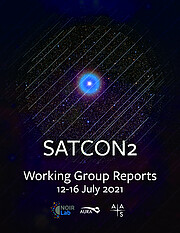SATCON2 Working Group Reports Released
Most comprehensive study of satellite constellations concludes seminal conference
29 October 2021
The SATCON2 workshop addressed a watershed moment in the transformation of space. In 2018, a few thousand operational satellites orbited the Earth. By 2030, there may be more than 100,000. A massive cloud of satellites presents significant to existential impacts on ground-based astronomy, and further impacts that extend to the environment, astro-tourism, and human health. While space offers many new frontiers and benefits to humanity, the sudden advance of spacefaring technology to the private sector comes with many side effects that should be carefully considered.
SATCON2 brought together members of many communities: astronomy, satellite operators, environmental and dark-sky advocates, and representatives from diverse and underrepresented communities. The details of their comprehensive work are presented in 4 reports from the working groups — Observations, Algorithms, Community Engagement and Policy — which have been compiled and are being released today. The Observations and Algorithms working groups explored some SATCON1 recommendations directly, and their reports propose observing and software solutions through an entity called SatHub. The Community Engagement working group’s report introduces new voices and perspectives on the issue, and the Policy working group’s report discusses regulatory framework and mitigation approaches from national, international, and industry viewpoints.
The SATCON2 Scientific Organizing Committee and the many members of the working group have prepared these reports in the hope that they will provide a roadmap for addressing the impact on all of us of the industrialization of space.
An executive summary of the SATCON2 conference was released two weeks ago on 15 October 2021 and can be found here.
More information
NSF’s NOIRLab (National Optical-Infrared Astronomy Research Laboratory), the US center for ground-based optical-infrared astronomy, operates the international Gemini Observatory (a facility of NSF, NRC–Canada, ANID–Chile, MCTIC–Brazil, MINCyT–Argentina, and KASI–Republic of Korea), Kitt Peak National Observatory (KPNO), Cerro Tololo Inter-American Observatory (CTIO), the Community Science and Data Center (CSDC), and Vera C. Rubin Observatory (operated in cooperation with the Department of Energy’s SLAC National Accelerator Laboratory). It is managed by the Association of Universities for Research in Astronomy (AURA) under a cooperative agreement with NSF and is headquartered in Tucson, Arizona. The astronomical community is honored to have the opportunity to conduct astronomical research on Iolkam Du’ag (Kitt Peak) in Arizona, on Maunakea in Hawai‘i, and on Cerro Tololo and Cerro Pachón in Chile. We recognize and acknowledge the very significant cultural role and reverence that these sites have to the Tohono O'odham Nation, to the Native Hawaiian community, and to the local communities in Chile, respectively.
The American Astronomical Society (AAS), established in 1899, is a major international organization of professional astronomers, astronomy educators, and amateur astronomers. Its membership of approximately 8,000 also includes physicists, geologists, engineers, and others whose interests lie within the broad spectrum of subjects now comprising the astronomical sciences. The mission of the AAS is to enhance and share humanity’s scientific understanding of the universe as a diverse and inclusive astronomical community, which it achieves through publishing, meetings, science advocacy, education and outreach, and training and professional development.
The Scientific Organizing Committee of SATCON2 thanks the National Science Foundation (NSF), NSF’s NOIRLab, and the American Astronomical Society for their support of SATCON2.
Links
- SATCON2 Working Group Reports
- SATCON2 Executive Summary
- SATCON2 website
- SATCON2 Press Conference
- SATCON1 Report
- SATCON1 Press Conference
- Dark & Quiet Skies 2020 Report
- IAU Statement on Satellite Constellations
- AAS Statement on Satellite Constellations
Contacts
Connie Walker
NSF’s NOIRLab, Co-Chair SATCON2
Tucson, Arizona, USA
Email: connie.walker@noirlab.edu
Jeffrey Hall
Lowell Observatory, Co-Chair SATCON2
Chair, AAS Committee on Light Pollution, Radio Interference, and Space Debris
Flagstaff, Arizona, USA
Email: jch@lowell.edu
Lars Lindberg Christensen
NOIRLab Head of Communications, Education & Engagement
Cell: +1 520 461 0433
Email: lars.christensen@noirlab.edu
Susanna Kohler
Communications Manager and Press Officer
American Astronomical Society
T: +1 202 328 2010 x127
Email: susanna.kohler@aas.org


